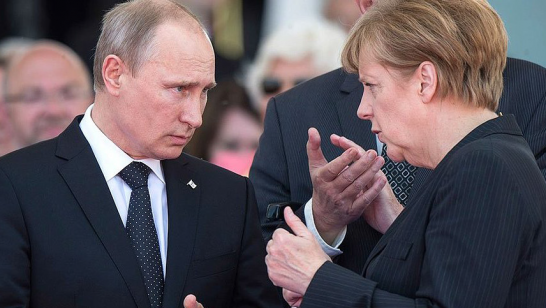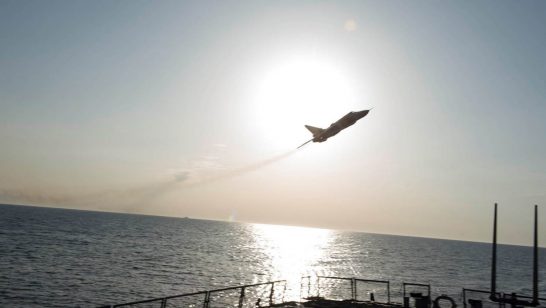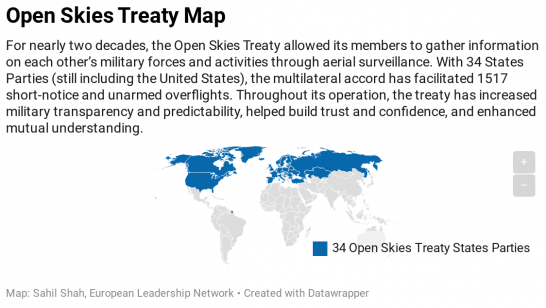
The foundations of the Euro-Atlantic security order are eroding. The years since the 2001 withdrawal by the United States from the Anti-Ballistic Missile Treaty (ABMT) have seen a host of such agreements, so painstakingly negotiated in order to bring a semblance of predictability and stability to the region, cancelled or undermined.
The list of the damage is a long one. For example, Russia suspended its participation in the Conventional Forces in Europe Treaty (CFE) in 2007 and officially halted all cooperation in 2015, whilst railing against NATO deployments to the territory of new members in the east. Western states accuse Russia of violating the spirit, if not the letter, of the OSCE Vienna Document on confidence and security building measures in order to avoid international observation and pre-notification of its largest military exercises. Through its 2014 annexation of Crimea, Russia has overturned the principles sovereignty and territorial integrity of the Helsinki Final Act, whilst disregarding its own assurances of Ukrainian territorial integrity, through the Budapest Memorandum, which set the conditions for the withdrawal of Soviet nuclear weapons from that country. All NATO-Russia Council cooperative projects remain suspended, whilst Russia and the United States trade accusations over the other side’s perceived violation of the Intermediate-Range Nuclear Forces Treaty (INF).
Alongside this long list, one agreement has persevered: the Open Skies Treaty (OST). The OST was initially conceived as a bilateral US-USSR initiative in 1989, [1] but was swiftly multilateralised to a current total of 35 signatories, entering into force in 2002. The Treaty permits member states to conduct observation flights over the territory of other members (in the presence of representatives of the state being observed), allowing the collection of photographs and other pre-agreed sensor data relating to militarily significant facilities. This data is then made available to all other signatory states through a pooled repository hosted by the OSCE.
The OST works as a stand-alone confidence and security building measure (CSBM) as well as a facilitator for arms control agreements (most prominently for New START [2]) by increasing the transparency of national force postures throughout the Euro-Atlantic space. The aerial imaging collected by OST flights is a valuable resource to those states without access to advanced satellite systems. It allows them to verify, to some degree at least, that any change of force posture by their neighbours does not signify aggressive intent. This collectively pooled intelligence serves to lessen regional security dilemmas, whereby a military build-up perceived as defensive by the initiating state triggers a similar build-up by neighbouring states that fear aggression, thus triggering an unintended downward spiral of mistrust and suspicion. The Treaty is regularly lauded by many of its signatories. [3]
However, even the OST has not proven immune from the deterioration of relations between Russia and its neighbours. Some in the United States, for example, have raised concerns about Russian overflights of American territory following an upgrade to the observation equipment in Russian aircraft, ultimately threatening effective US participation in the Treaty. [4] Russia for its part has restricted access by outside observers to sensitive areas such as the Kaliningrad exclave. [5] Tensions between Greece and Turkey over potential Cypriot accession to the Treaty have also at times led to a partial suspension of the Treaty’s provisions.
Arguably of even greater concern is the total suspension of the Treaty’s mechanisms between Russia and Georgia, in relation to the contested nature of Abkhazia and South Ossetia.
Paragraph 2 Section 2 of the Treaty allows for the legitimate refusal of access to an area bordering a non-signatory state. [6] It is on this basis that Russia, having formally recognised Abkhazia and South Ossetia as independent states in August 2008, began in May 2010 to deny the right of overflight to OST observers (a joint US-Romania flight in the first instance) over the Russian territory contiguous with these two breakaway regions. This has remained a consistent policy, and ultimately no such request was made in 2016. [7] It is in response to this Russian policy that Georgia, in 2012, formally suspended Russia’s right to observe its territory. [8]
The role of disputed territories as spoilers for arms control agreements and confidence and security building measures is not new. But in the context of increased Russia-West confrontation and eroding security agreements, it is particularly important that all possible options for addressing misperception and reducing risk should be carefully considered. During the present period of increased military activity throughout the wider region, the reduction of mutual observation between Russia and Georgia leads to uncertainties over military intent and to exaggerated risk perceptions.
It is important to note that efforts to resolve the absence of OST overflights in no way undermine Georgia’s rightful claim to its territorial integrity. Such efforts merely seek to improve trust on a military-political level between Tbilisi and Moscow, thus reducing the risk of unintended military confrontation and facilitating more stable conflict resolution.
A Status-Neutral Approach
In short, it would be desirable to find a mechanism by which OST flights could resume between Russia and Georgia in a way that did not impinge on the issue of the international status of Abkhazia and South Ossetia.
There are two principal options for such a mechanism. The first would be a Georgia-Russia process mediated by a third party, with the exclusion of the Sukhumi and Tskhinvali authorities. The second would be a process with the involvement of Sukhumi and Tskhinvali on a status-neutral basis.
Russia and Georgia have at times adopted a distinctly pragmatic approach to the contested regions when the end-goal was clearly in the mutual interest of both Moscow and Tbilisi. Indeed, Russia and Georgia, with the participation of the UK, conducted reciprocal OST flights over each other’s territory in October 2009, more than a year after Russia’s recognition of Abkhazia and South Ossetia. [9] Such an action is a clear indication that, should political will be forthcoming, practical measures to limit tensions are possible in the most trying of circumstances.
A further example is the negotiation preceding Russia’s accession to the World Trade Organisation (WTO) in August 2012. These negotiations excluded the separatist authorities completely, despite their eventual encompassing of Sukhumi-controlled territory. The agreement reached confers on Abkhazia the status of ‘trade corridor’, an area through which goods can be moved in accordance with a neutral monitoring regime. [10] This monitoring regime entails the administration of customs affairs at either end of the corridor by a private Swiss company (SGS) that in turn coordinates with the WTO. [11] Crucially, Abkhazia is not mentioned by name in this agreement, thus avoiding irreconcilable Russian-Georgian stances on status. Instead, the territory comprising the trade corridor is delineated purely through geographical coordinates. This approach successfully circumvented the contested status of Abkhazia and permitted the functional application of a multilateral regime.
Were Moscow and Tbilisi to accept that it was in their mutual interest to restart OST flights over each other’s territory the WTO agreement provides a sensible model for facilitation, with the OSCE as a natural arbiter.
Provisions on the implementation of status neutral CSBMs are included in the 1993 OSCE document on Stabilising Measures for Localised Crisis Situations. [12] Whilst this document has never been used in practice, it does contain a number of principles that directly lend themselves to facilitating OST flights in contested areas. [13]
The document consists of an initial “Concept and Principles of Application” and a “Catalogue” of possible areas of implementation.
Paragraph 9 of the “Concept” emphasises that:
“The parties involved in a particular crisis situation will be identified in each case in accordance with the relevant norms of international law and CSCE provisions. When such parties are not States, their identification and subsequent participation in a crisis prevention, management and/or settlement process does not affect their status.”
Paragraph 10 goes on to offer the OSCE as a third party mediator in such cases. Most pertinently, paragraph 6 of the “Catalogue’s” section D on “Measures for Monitoring of Compliance and Evaluation”, in support of its principles, outlines a potential “Aerial Observation Regime”, possibly “using procedures and measures agreed within the framework of [the] Open Skies regime”.
This potential “Aerial Observation Regime” offers “Conduct by a third party of overflights, with possible participation of representatives of the parties involved, aimed at checking compliance with agreed stabilising measures and building confidence (augmented by [O]SCE-arranged flights)”.
In principle, these points provide a framework through which the OSCE and the Open Skies Consultative Commission (OSCC) could, in OSCE-operated aircraft, [14] facilitate overflight of Russian and Georgian territory without altering any national position on the status of Abkhazia or South Ossetia. It is even plausible that such flights could cover the territory of Abkhazia and South Ossetia, delineated purely through geographical coordinates as in the Russia-Georgia WTO deal. Indeed, Annex L to the OST (Section III) stipulates that the OSCC shall consider requests from the OSCE and other relevant international bodies for facilitating extraordinary observation flights over the territory of a State Party with its consent for purposes of conflict prevention and crisis management. [15] This annex was first used to facilitate overflights of the Russia-Ukraine border area in early 2014, highlighting its relevance in contested areas.
Should the lack of Sukhumi’s and Tskhinvali’s participation threaten to render the above proposal unworkable it may be plausible to frame status-neutral OST flights as part of the Incident Prevention and Response Mechanisms (IPRMs) agreed by the conflict parties [16] in February 2009 and resumed in March 2016 after a four year suspension. These mechanisms are designed to facilitate the exchange of security-related information, but lack a system of verification. OST flights over Abkhazia and South Ossetia might, in part, fulfil that role. Despite the fact that the Georgian IPRMs are currently chaired by the UN, OSCE-operated OST flights would adhere to the IPRM’s status-neutral remit.
A Mechanism in the National Interest
An increasing NATO presence in Georgia (a NATO training centre opened in Tbilisi-controlled territory in August 2015 and major Allies regularly exercise in the country [17]) makes a resumption of Russian OST flights over Georgia of clear interest to Moscow. Similarly, the exclusion of naval forces from major arms control treaties leaves the OST as the only multilateral method for Russia to monitor Georgian modifications to the port of Poti, [18] a basing area that has been offered by Tbilisi to NATO. [19] Despite the continued overflight of Georgia by other OST signatories, [20] Russia has continued to lodge requests of its own, a clear indication that OST flights still have utility in Russian planning. [21]
An added incentive is the short-term obsolescence of Russian satellite reconnaissance capability. Whilst the deterioration of Russia’s existing array is scheduled to be addressed from 2019 onwards, [22] the under-funding of Roscosmos, the Russian space agency, and a series of consequential rocket failures, puts this timeframe in doubt. [23] As was noted by former US Secretary of State George Shultz in 2012, for states without sophisticated satellite systems, Open Skies represents their only legitimate means of alleviating security concerns through the collection of timely overhead imagery. [24] The Russian focus on upgrading its OST aircraft camera arrays, first in Europe and then North America, is an added indication that aerial photography retains an important supplementary role to satellite imagery. Even if Russia is only temporarily in such a position, a return to OST cooperation with Georgia at present has clear value for Moscow.
Insight into the Russian force posture in the North Caucasus would be a clear gain for Georgia. Whilst Georgia retains access to the data resulting from OST flights elsewhere over Russian territory through the central repository, this is unlikely to provide the level of reassurance that would be necessary for Tbilisi to alter its own posture. Bilateral intelligence sharing agreements between Georgia and the US may help to make up for the loss of OST data, [25] however OST flights would help to validate this intelligence and provide a safety net in case in case bilateral agreements are revoked in the future. Similarly, the use of status-neutral OST flights as a verification mechanism for the Georgian IPRMs, themselves an underlying factor in the Georgian commitment to the non-use of force against Abkhazia and South Ossetia, would be a net security gain for Georgia.
That the OST overflight process involves direct coordination, and indeed co-participation, between the personnel of both the observer and the observed, adds additional value as a confidence building measure. This interaction builds familiarity that would be of benefit in the operation of other CSBMs, such as the OSCE Vienna Document.
A Model for Crimea?
It remains an open question whether Moscow and Tbilisi will judge their national interests to be affected to such an extent that they would consider the approach outlined here. But broad trends in Euro-Atlantic security suggest that they might indeed do so. The increase in tensions between Russia and its western neighbours has led to a significant adjustment in force postures, whilst the information exchange measures included in the Vienna Document have come under strain. The need for reassurance is greater than it has been for decades.
Should a status-neutral approach to the OST prove to be workable in the Georgia-Russia case, it is possible that this could provide a basis for a similar approach in other conflicts, the primary candidate being Crimea. [26] Whilst OST flights have taken place between Ukraine and Russia (and by third parties along their common border) since the Russian intervention, these flights have thus far not covered the Crimean Peninsula. In May 2014 Russia did invite OST flights by signatory states over Crimea as a part of missions over Russia, but this was declined because it would imply recognition of the Russian annexation. [27] Lack of information relating to Russian deployments to Crimea is a major driver of regional insecurity.
There are, however, some negative trends that would make a return to OST cooperation between Russia and Georgia harder. The rapid development of UAV technology may lead Russia to opt for illicit aerial observation using drones in preference to renewed cooperation on the OST. And there is a more structural Russian grievance. NATO signatories of the OST do not use their respective quotas to overfly each other’s territory, thus significantly reducing the repository of images of NATO countries held by the OSCE. It can be argued that this consequently requires Russia to utilise its flight quota more heavily than it would otherwise over NATO member states, leaving less capacity to devote to any potential overflight of Georgia. [28]
The opinions articulated above represent the views of the author(s), and do not necessarily reflect the position of the European Leadership Network or any of its members. The ELN’s aim is to encourage debates that will help develop Europe’s capacity to address the pressing foreign, defence, and security challenges of our time.
Endnotes
[1] The concept of mutual aerial observation was first suggested by President Eisenhower in 1955, however this was rejected by the Soviet leadership.
[2] Hartwig Spitzer, “Open Skies: transparency in stormy times”, Trust and Verify (VERTIC), July-September 2014, Issue No. 146, p.6 http://www.vertic.org/media/assets/TV/TV146.pdf
[3] “Open Skies Treaty is important for building trust and promoting transparency”, Open Skies Consultative Commission, 8 June 2015 http://www.osce.org/oscc/162771
[4] Thomas Graham Jr, “Don’t Enshrine A Russian Advantage In Surveillance Flights Over the US”, Defense One, 17 July 2017 http://www.defenseone.com/ideas/2017/07/dont-enshrine-russian-advantage-surveillance-flights-over-us/139492/?oref=d-river
[5] “2017 Report on Adherence to and Compliance With Arms Control, Nonproliferation, and Disarmament Agreements and Commitments”, U.S. Department of State, 14 April 2017 https://www.state.gov/t/avc/rls/rpt/2016/255651.html
[6] “The flight path of an observation aircraft shall not be closer than, but shall be allowed up to, ten kilometres from the border with an adjacent State that is not a State Party.” Treaty on Open Skies http://www.nti.org/media/pdfs/aptoskies.pdf?_=1316557070
[7] “2017 Report on Adherence to and Compliance With Arms Control, Nonproliferation, and Disarmament Agreements and Commitments”, U.S. Department of State, 14 April 2017 https://www.state.gov/t/avc/rls/rpt/2016/255651.html
[8] “Statement of the Ministry of Foreign Affairs of Georgia on a decision to cease performing its obligations vis-a-vis the Russian Federation under the Open Skies Treaty”, 5 April 2012, http://italy.mfa.gov.ge/index.php?lang_id=ENG&sec_id=193&info_id=14626
[9] “Georgia-UK-Russia Joint Surveillance Flights”, Civil.ge, 9 October 2009, http://www.civil.ge/eng/article.php?id=21554
[10] WTO regulations do not apply to goods traded within the trade corridor, only to those that transit it.
[11] “Lavrov: 2011 Georgia-Russia WTO Deal ‘Does Not Cover Abkhazia, S.Ossetia’”, Civil.ge, 11 March 2015, http://civil.ge/eng/article.php?id=28119
[12] “Stabilising Measures for Localised Crisis Situations”, OSCE, 25 November 1993, http://www.osce.org/fsc/42314?download=true
[13] For a full study of potential uses for the document on ‘Stabilising Measures’ see Sergi Kapanadze, Ulrich Kühn, Wolfgang Richter and Wolfgang Zellner, Status-Neutral Security, Confidence Building and Arms Control Measures in the Georgian Context”, CORE Working Paper 28, January 2017, https://ifsh.de/file-CORE/documents/Working_Papers/CORE_WP28_en_.pdf
[14] An OSCE-operated aircraft could be interpreted as an aircraft piloted by contractors identified by the OSCC, with photographic equipment operated in a similar manner. The aircraft itself could be contracted from another OST signatory state. It is reasonable to assume that Moscow and Tbilisi would fund such a flight in accordance with a conventional OST flight.
[15] Loïc Simonet, “Open Skies: successes and uncertainties of an iconic post-Cold War instrument”, OSCE, 7 March 2012, http://www.osce.org/oscc/104038
[16] Tbilisi, Moscow, Sukhumi, and Tskhinvali
[17] Margarita Antidze, “Georgia begins U.S.-led military exercise, angering Russia”, Reuters, 11 May 2016, http://www.reuters.com/article/us-georgia-exercises-idUSKCN0Y21RP
[18] Poti is the headquarters of the Georgian Coast Guard (since 2009 the successor to the Georgian Navy)
[19] Joshua Kucera, “Georgia Offers NATO to Build a Black Sea Base at Poti”, Eurasianet.org, 9 March 2017, http://www.eurasianet.org/node/82736
[20] In 2016 Georgia was overflown by a joint German-Turkish delegation, a joint Canadian-French-Italian delegation, and a Ukrainian delegation.
[21] Russia requested flights over Georgia in 2015 and 2016, withdrawing the latter after a Georgian veto.
[22] “Russia Developing Reconnaissance Satellite System”, defence-aerospace.com, 30 December 2016, http://www.defense-aerospace.com/articles-view/release/3/179951/russia-developing-new-5_satellite-reconnaissance-system.html
[23] Asif Siddiqi, “Russia’s Space Program Is Struggling Mightily”, Slate, 21 March 2017, http://www.slate.com/articles/technology/future_tense/2017/03/russia_s_space_program_is_in_trouble.html
[24] George P. Shultz, Sidney D. Drell, & Christopher Stubbs, “Modernize Open Skies”, New York Times, 25 March 2012, http://www.nytimes.com/2012/03/26/opinion/26iht-edshultz26.html
[25] “United States and Georgia Sign General Security of Information Agreement”, U.S. Department of State, 9 May 2017, https://www.state.gov/r/pa/prs/ps/2017/05/270754.htm
[26] Azerbaijan, Armenia, and Moldova are not signatories to the OST, so it is premature to consider such an application to Nagorno-Karabakh and Transnistria respectively.
[27] Hartwig Spitzer, “Open Skies: transparency in stormy times”, Trust and Verify (VERTIC), July-September 2014, Issue No. 146, p.4 http://www.vertic.org/media/assets/TV/TV146.pdf
[28] Russia, jointly with Belarus, has an annual allotment of 42 observation missions for use over other OST signatories (known as the ‘active quota’), whilst being obliged to receive up to 42 observations of its own, and Belarusian, territory (known as the ‘passive quota’).



